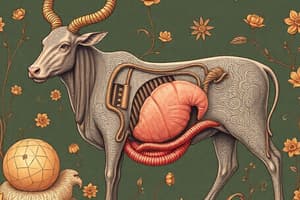Podcast
Questions and Answers
Which of the following animals has a simple digestive system?
Which of the following animals has a simple digestive system?
- Hydra (correct)
- Earthworm
- Grasshopper
- Cnidarians
The digestive system of an earthworm is classified as an incomplete digestive tract.
The digestive system of an earthworm is classified as an incomplete digestive tract.
False (B)
What process starts when earthworms ingest soil?
What process starts when earthworms ingest soil?
Digestion
In grasshoppers, the digestive system consists of three regions: the foregut, midgut, and __________.
In grasshoppers, the digestive system consists of three regions: the foregut, midgut, and __________.
Match the animal with its type of digestive system:
Match the animal with its type of digestive system:
What part of the grasshopper's foregut serves both as a grinding organ and regulates food flow to the midgut?
What part of the grasshopper's foregut serves both as a grinding organ and regulates food flow to the midgut?
The phylum Cnidaria includes hard-shelled organisms like corals and soft-bodied jellyfish.
The phylum Cnidaria includes hard-shelled organisms like corals and soft-bodied jellyfish.
What is the function of the gizzard in an earthworm's digestive system?
What is the function of the gizzard in an earthworm's digestive system?
What is the primary function of the midgut?
What is the primary function of the midgut?
The hindgut is responsible for nutrient absorption and initial digestion.
The hindgut is responsible for nutrient absorption and initial digestion.
What term is used to describe the semi-fluid mass food transforms into in the stomach?
What term is used to describe the semi-fluid mass food transforms into in the stomach?
The small intestine is lined with finger-like projections called __________, which are essential for nutrient absorption.
The small intestine is lined with finger-like projections called __________, which are essential for nutrient absorption.
Match the following digestive organs with their primary roles:
Match the following digestive organs with their primary roles:
Which enzyme is primarily involved in the breakdown of dietary fats?
Which enzyme is primarily involved in the breakdown of dietary fats?
The process of defecation is part of the six main activities involved in human digestion.
The process of defecation is part of the six main activities involved in human digestion.
What are the three segments of the small intestine?
What are the three segments of the small intestine?
Flashcards
Midgut function
Midgut function
The midgut is the primary site for digesting food, secreting enzymes and perithropic matrix components.
Hindgut function
Hindgut function
The hindgut is responsible for final digestion, nutrient absorption, and waste excretion.
Human Digestion Processes
Human Digestion Processes
Ingestion, propulsion, mechanical digestion, chemical digestion, absorption, and defecation.
Mechanical Digestion
Mechanical Digestion
Signup and view all the flashcards
Chemical Digestion
Chemical Digestion
Signup and view all the flashcards
Small Intestine Segments
Small Intestine Segments
Signup and view all the flashcards
Villi function
Villi function
Signup and view all the flashcards
Nutrient absorption in the small intestine
Nutrient absorption in the small intestine
Signup and view all the flashcards
Hydra Digestive System
Hydra Digestive System
Signup and view all the flashcards
Earthworm Digestive System
Earthworm Digestive System
Signup and view all the flashcards
Complete Digestive Tract
Complete Digestive Tract
Signup and view all the flashcards
Grasshopper Foregut
Grasshopper Foregut
Signup and view all the flashcards
Crop (Digestive)
Crop (Digestive)
Signup and view all the flashcards
Gizzard (Digestive)
Gizzard (Digestive)
Signup and view all the flashcards
Digestion
Digestion
Signup and view all the flashcards
Cnidarians
Cnidarians
Signup and view all the flashcards
Study Notes
Digestion: An Overview
- Digestion is a vital biological process where organisms break down food into simpler forms for cell use.
- Different animals have diverse digestive mechanisms adapted to their diets and environments.
Examples of Digestive Systems in Animals
Hydra
- Hydra is a multicellular, microscopic creature in freshwater environments.
- It has a simple digestive system.
- Its name reflects its resemblance to a mythological creature.
- Hydra has a cylindrical body with tentacles for capturing prey.
- This structure enables efficient feeding in aquatic environments.
Cnidarians
- Cnidaria is a phylum encompassing soft-bodied, stinging organisms like corals, sea anemones, and jellyfish.
- The name "Cnidaria" comes from the Greek word cnid, meaning "nettle," referring to their stinging abilities.
Earthworm
- Earthworms (annelids) have a complete digestive tract, a long tubular structure with a mouth and anus.
- Their digestive system is divided into specialized regions (mouth, pharynx, esophagus, crop, gizzard, intestine, and anus).
- They feed on decaying plant material in soil.
- During burrowing, they ingest soil which aids digestion.
- The food travels through the pharynx, esophagus, crop, and gizzard. Muscular gizzard walls grind the food with help from ingested soil.
Grasshopper
- Grasshoppers (arthropods) have a three-part digestive system (foregut, midgut, and hindgut).
- The foregut includes the buccal cavity, pharynx, esophagus, crop, and proventriculus. The proventriculus grinds food and controls passage into midgut.
- The midgut is the main site of digestion and absorption.
- The hindgut processes remaining material and expels waste through anus.
Human Digestion
- Human digestion involves six key processes: ingestion, propulsion, mechanical digestion, chemical digestion, absorption, and defecation.
- Digestion begins in the mouth with mechanical breakdown by teeth and tongue, and chemical breakdown by saliva initiating starch digestion.
- Food travels down the pharynx, into the esophagus to the stomach where it's churned and chemically digested using enzymes like pepsin and hydrochloric acid.
- It's converted to chyme and stored in the stomach.
- The small intestine completes digestion, using enzymes secreted by the pancreas and bile from the liver to break down fats, carbs and proteins.
- Villi in the lining absorb nutrients. Lacteals absorb fats.
- Remaining water and waste are consolidated in the large intestine and expelled as feces.
Studying That Suits You
Use AI to generate personalized quizzes and flashcards to suit your learning preferences.




